As an online store owner, you most likely sell your goods to many different people and regularly interact with them.
But does it mean that you really know them?
Customers are not a uniform group of people. They don’t all share the same characteristics and expectations. So, your job is to learn about them as much as possible.
And the best way to approach this is to use the so-called customer segmentation strategy.
With it, you can send the right messages to the right customers and personalize your communication to answer their specific needs.
Here’s how to do it.
In this article:
- Customer segmentation definition
- Benefits of using this method
- Types of customer segmentation
- Best strategies you can use for optimal results
Learn how to use AI to segment customers and provide support
Do you want to find out more about how to personalize communication with your clients and enhance your customer relationship? Check out these articles:
- Customer Communication: 6 Effective Strategies [+Tips]
- Customer Satisfaction: All You Need to Know [+Tips]
- What Is Customer Relations? Definition, Benefits & Tips
Let us start from the very beginning—
What is customer segmentation?
Customer segmentation is the method of dividing customers into specific groups according to similar characteristics, behavior patterns, preferences, and needs. With this method, you can easily target particular groups of customers and reach out to them with the right message at the right moment.
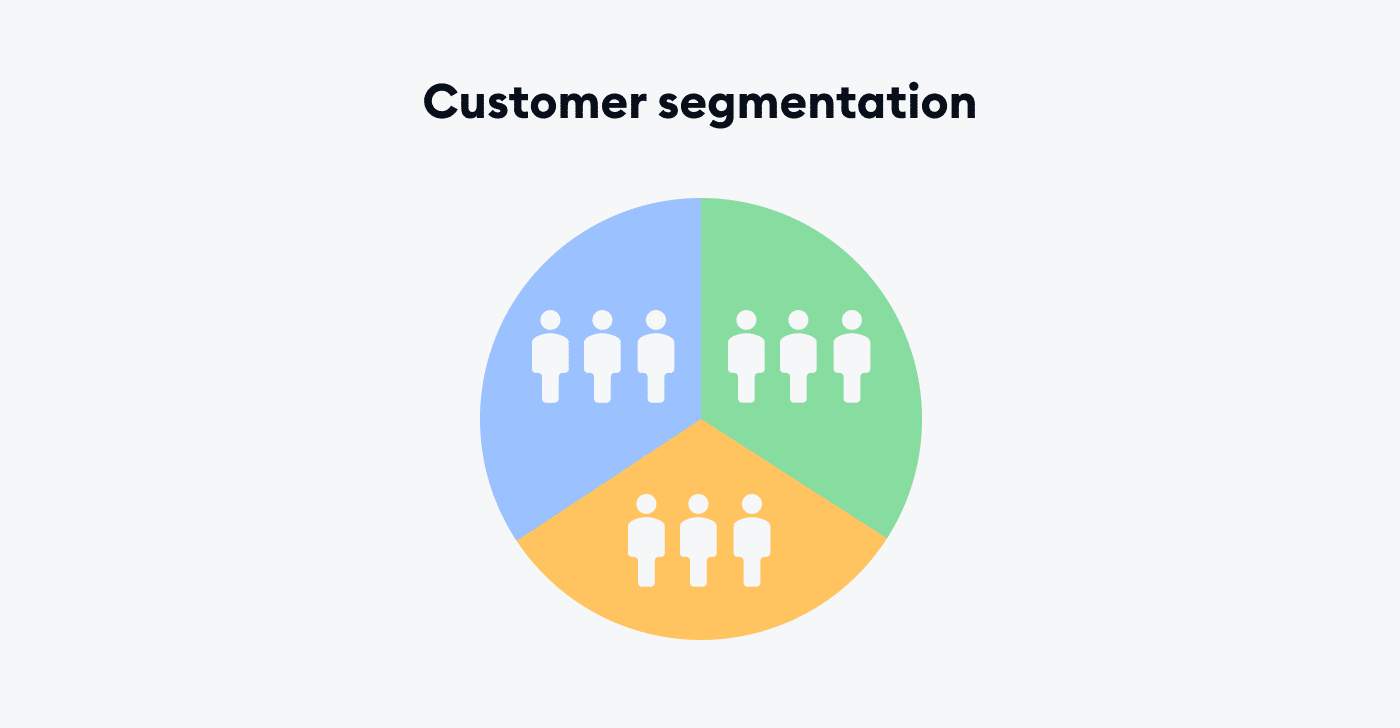
Now, what is a customer segmentation strategy?
A client segmentation strategy is a set plan according to which a business tags its customers. For example, a brand that sells lingerie will most likely segment its customers according to gender. Depending on the type of lingerie the business sells, it could also divide shoppers according to age, marital/relationship status, and income. The brand can then target segmented customers using personalized marketing and sales efforts.
With that out of the way, let’s be more specific—
What is a customer segment?
Simply put, a customer segment is a group of clients that have similar interests, needs, and/or characteristics. By dividing customer segments according to similar traits, you can determine the best way to promote and market your products to each segment. And this only leads to increased consumer loyalty and customer retention in the long run.
Also, while we’re here, it would be beneficial to distinguish between the following—
Market segmentation vs. customer segmentation
In a nutshell, market segmentation is the process of analyzing and segmenting the entire target market based on specific traits. These can be distinguished by four segmentation models:
- demographic
- geographic
- behavioral
- psychographic

On the other hand, client segmentation further divides your existing customer base and compartmentalizes them according to their specific needs, behaviors, and traits.
Therefore, market segmentation is most often used to connect with new, potential customers to make sure that your new products and services meet their needs.
Customer segmentation, by contrast, is best for helping you understand your current clients and improve the way you market your products to specific groups.
Keep in mind that for the best results, you should perform both strategies regularly.
But what are the actual benefits your business can gain if you use customer segmentation?
Let’s find out.
Benefits of customer segmentation
By performing detailed segmentation of your clients, you can learn much more than what groups you can fit them into. Rather, this process allows you to get to know them thoroughly and completely. Then, you can use all that knowledge to your advantage.
So, this strategy can not only help you improve the way you do your business as a whole, but it can also be valuable for your customers.
Let’s examine the different benefits of using a customer segmentation model in your marketing strategy.
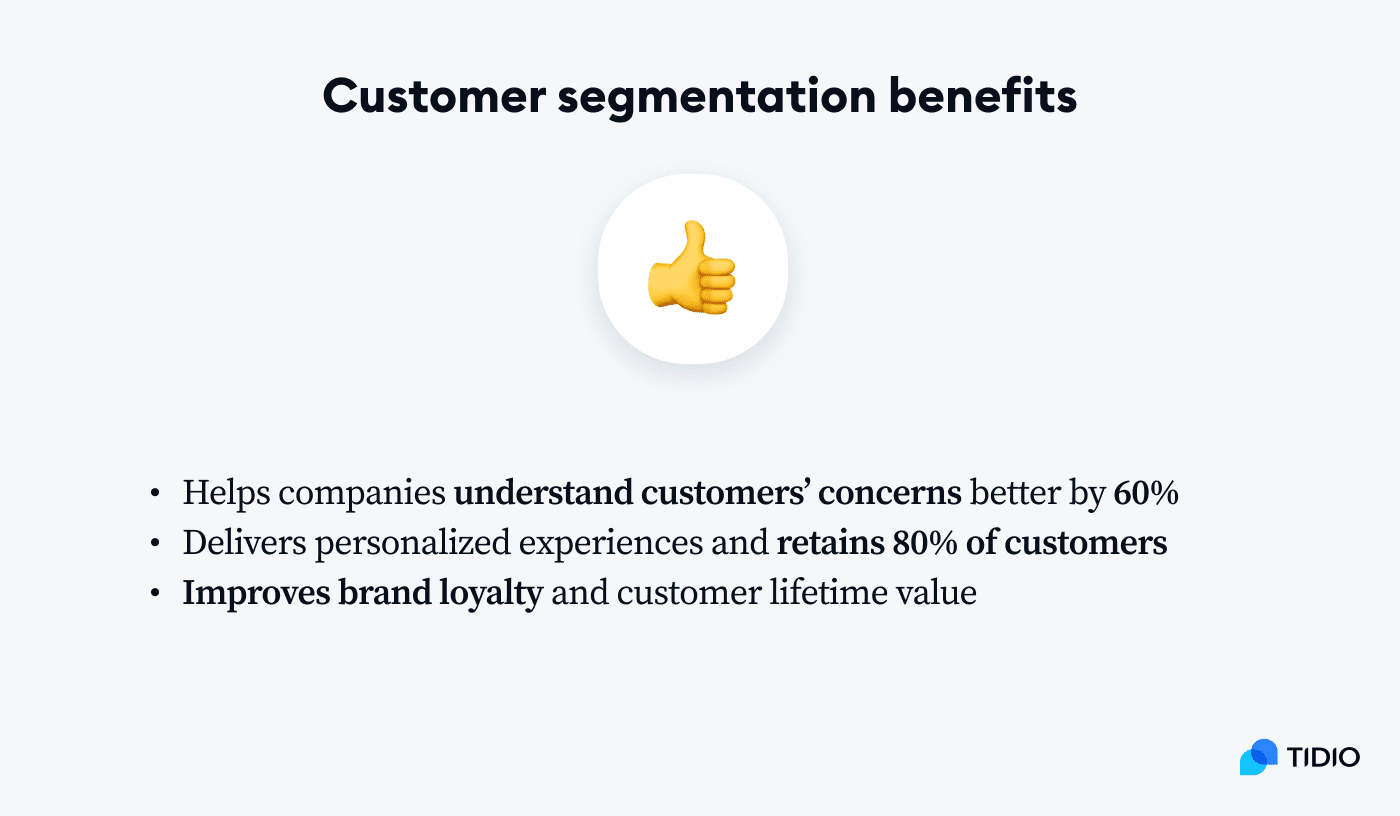
1. It can improve your customer service and support efforts
Conducting regular segmentation of your clients can enhance your customer service and support efforts. By understanding your customer segments better, your support reps will get a better knowledge of the potential behavior they can expect when interacting with certain groups.
Moreover, segmentation is 60% more likely to help companies understand customers’ challenges and concerns.
So, your support agents will also be aware of potential problems and challenges they can encounter when talking to users. The end result—higher quality of your customer service and more personalized experiences for each client.
Which brings us to our next point—
2. It can help you deliver more personalized experiences
Nowadays, clients are looking for personalized experiences more than ever. In fact, around 80% of consumers are more likely to make a purchase if a brand offers a tailored experience.
Therefore, it’s extremely important to have an established customer segmentation strategy. By doing so, you’ll be able to understand specific customer needs and deliver top-notch experiences to each one of your shoppers.
Also, if you perform thorough and regular customer segmentation analysis, you will be able to personalize each step of the customer journey.
So, finally—
3. It can improve brand loyalty and customer lifetime value
Through consistent efforts to personalize your clients’ experiences, you can boost their loyalty towards your brand.
It’s quite simple—the more satisfaction they get from interacting with your business, the better potential for them to regard you as trustworthy and stick around for the long haul. And improved brand loyalty leads to increased customer lifetime value, so it’s a win-win situation all around.
Read more: Learn all you need to know about customer lifetime value, its formula, and its importance.
Okay—
Now you have a good idea of why customer segmentation is important in the first place. But what are the most common models used in a customer segmentation strategy?
Let’s take a more detailed look.
Customer segmentation examples
Just like with marketing segmentation, there are more than a few different ways to group your clients. Traditionally, there are 4 types of customer segmentation models—demographic, geographic, behavioral, and psychographic.
That being said, there are a few other types that are worth mentioning, too. So, let’s go through all of the most commonly used approaches and examples of customer segmentation.
1. Demographic segmentation
This is easily one of the most widely used segmentation methods. That’s because it includes many variants relevant to people’s purchase decisions. These include age/generation, gender, occupation, education, income, marital status, and more.

Say that you own a sportswear store that specializes in selling football equipment. As football is predominately popular among the male population, you’d most likely have to perform a demographic segment of your customers according to gender.
Below, you can find detailed examples of the demographic segments.

2. Geographic segmentation
This customer segment example allows you to group your customers according to criteria such as country, city, state, region, climate, or market size. Doing this type of segmentation is especially useful when your business operates across multiple locations.
In addition, you can benefit from knowing your customers’ local culture, the weather, and holidays. Thanks to these elements, you can approach them in a way that resonates with them better. For example, you can mention things that relate to them culturally, like their traditions, local slang, etc.

3. Behavioral segmentation
When performing behavioral segmentation, you essentially focus on how your customers interact with your brand.
What does it mean, exactly?
Basically, it means that you segment your customers based on their actions. For example, one segment would be for customers who abandoned their cart, while clients who browse but never buy anything would be put in another segment.

Other characteristics you may consider are:
- Time, day, or occasion during which they do their shopping
- Preferred method of payment or delivery
- The usual shopping routine of your customers
- The way they use the product they purchased
- The frequency your customers shop with you
Moreover, behavioral data may also take into account your customers’ history:
- The number of transactions they have had with you
- Whether they have referred your business to others
- Whether they are new or regular customers
4. Psychographic segmentation
When it comes to the psychographic customer segmentation model, your focus is on your customers’ personality traits, characteristics, values, beliefs, interests, and lifestyles. For marketers, this type of segmentation helps to select the customers who are most likely to become buyers. The selection may also be based on fan or interest-related groups, such as TV series addicts, environmentally-conscious citizens, comic book fans, etc.
Say that you own an online clothing store with a market segment of people in the age range of 18–35 years old. One part of them is buying your products, while there seems to be a hiccup with the other part. This is where the psychographic segment can come to the rescue.
For example, it can help you learn that there are many transgender and nonbinary folk within this group who would prefer your clothes to be more gender-nonconforming. Then, you can ensure to sell clothing that serves their needs better.
There are also several frameworks that can help you conduct psychographic segmentation.
Let’s take a brief look at some of them.
VALS
The abbreviation VALS stands for Values and Lifestyles (or Values, Attitudes, and Lifestyles).
This framework is used to predict customers’ behavior during their shopping journey. It assumes that the buyers’ motivations and resources determine how they express themselves in the marketplace.
In other words, people buy things to fulfill their emotional needs or to find satisfaction.

By knowing the motivations behind the customers’ purchase decisions, sellers and marketers can accurately pinpoint their target audience.
The VALS framework distinguishes various customer types, such as:
- Innovators
- Thinkers
- Believers
- Achievers
- Strivers
- Experiencers
- Makers
- Survivors
Each of these types has its own motivation source (the reason behind the purchase) and is located on either the high or low resources end (income level).
DINKs, GLAMs, Yuppies (and many more)
There are quite a few notable groups to consider during the psychographic segmentation process. As in the case of VALS types, members of those groups have different reasons or motivations to buy. They also need to match their motivations with financial limitations.
Some of them are summarized in the table below.
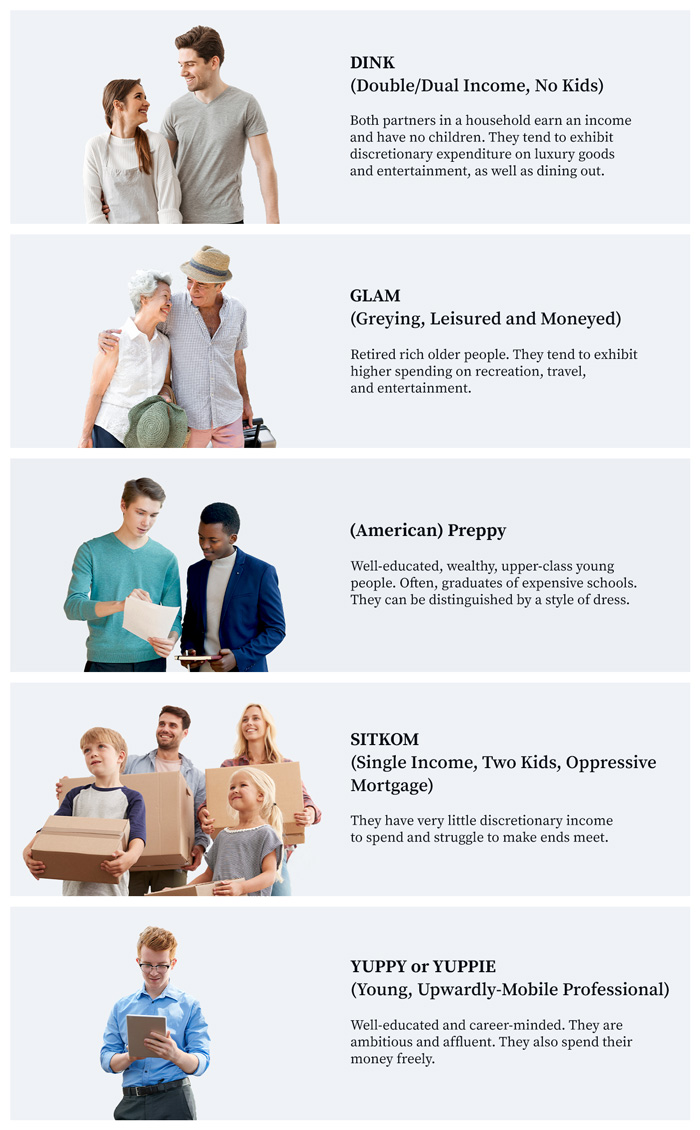
5. Value-based segmentation
Simply put, value-based consumer segmentation distinguishes customers by their economic value, i.e. the value they bring to the company itself. This segmentation method can be particularly useful if you feature different types of pricing for your products, including very cheap and very expensive offers.

Say that you own a tool for startups and individuals who are new to the business. Most likely, these would be the customers you’d segment as the ones with the smallest economic value. On the other hand, let’s say you offer a version of the tool that can accommodate huge corporations and enterprises. Then, these would be the high-value clients that are most profitable for your business.
6. Needs-based segmentation
This kind of segmentation is based on various needs customers have when it comes to a particular product or service. So, you can usually determine and group these target segments according to the most common customer wants and needs.

For example, if you own customer service software, you can segment customers by those in need of a live chat widget and those preferring the help of chatbots (and other AI-based tools). Of course, you can also group them by those who want to have both.
With that out of the way, let’s jump into different customer segmentation strategies you can implement in your business.
7 ecommerce segmentation strategies for immediate results
Certain tools and technologies allow you to easily segment customers in real time. And you can use them to incorporate some of the above-mentioned models into your customer segmentation strategy faster.
Without further ado, here are the best ways to segment your clients that will make your business drive sales through the roof.
1. Collect customer data
After setting specific goals you want to accomplish, it’s time to collect valuable customer data that will help you reach those goals.
One easy way of gathering such data is using a suitable CRM tool. Especially as most CRM software out there have all the features needed to easily analyze different types of customer data.
For example, you can use the functionality of your CRM to learn whether your visitors come from a particular location, what time they tend to visit your store the most, whether there’s a specific age group that comes most often, etc.
Once you’ve gathered these types of information, you can start creating more detailed segments according to them.
And if you ever need more details to create a specific segment, you can always gather the segment data from the customers themselves.
There are tons of different ways to obtain valuable insights. For example, you can monitor your social media channels and analyze what your clients write about their experience with your product. You may even learn more about some potential pain points they encountered along the way.
Or, you can place chat surveys directly on your site to gather all the info you may need.

If you have loyal and returning customers, you can schedule interviews with them to learn more about their interests, personality traits, and preferences. Then, you can ask them how (and if) any of it relates to your products. You can even organize social media contests and giveaways that require users to insert their experiences, thoughts and needs when it comes to your brand.
Last but not least, you can ask your visitors to add basic info about themselves when requesting of them to sign up for a mailing list, leave a review, and so on.
These strategies can help you get the data you need to create most, if not all customer segmentation types we mentioned above.
Of course, if you’re pulling data from disparate sources, you need to avoid having duplicate entries for the same customer in your system. That’s where entity resolution comes into play, as this technology allows you to analyze huge data records across multiple systems to identify when records for similar-looking entities are actually referring to different people, businesses, or locations.
Read more: Discover the importance of using ratings and reviews with the best tactics you can use to gain valuable customer feedback in your data collection.
2. Track and target your existing customers
When your existing customers are satisfied, they’re more likely to buy from you again. In fact, a whopping 89% of consumers are going to make another purchase if they have a positive shopping experience with a brand.
Also, it’s far more cost-effective to persuade previous buyers to make a repeat purchase than it is to acquire a new customer.
That’s why your existing customers are your most important segment of all.
Luckily, you can easily track your visitors with the help of chatbot software.
Namely, there’s a discreet checkout chatbot that will automatically assign a contact property or tag to each visitor who completes the checkout process. Such visitors will be saved to your database along with the contact property or tag—both actions work well for segmentation purposes.
Here’s a simple template of such a chatbot.
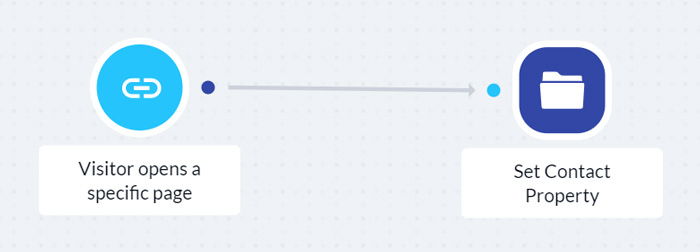
When the customer is done with placing their order, they are normally redirected to the Thank you for buying with us page. You should specify the URL of the checkout page in the chat trigger (so the bot knows when to activate), and then add the contact property name.
This chatbot will help you create a segment of customers who already ordered from you at least once. You can name this segment however you want, but keep it precise, e.g. “Transaction complete” or “Made a purchase” (to match the contact property).
If you don’t have a unique page that your customers visit after completing their purchase, it’s not a problem. You can trigger chatbots with any type of event you can think of using Tidio APIs.
Criteria ideas for segmenting customers based on their purchase behavior:
| Loyal buyer | Repeat customer |
| Purchased | Customer placed an order |
| Purchased [item category] | Customer bought a product from a specific product category |
| Purchased multiple [item category] | Customer bought more than one product from the same specific product category |
| High-end buyer | Customer bought high-end/expensive product |
| Purchased in [month] [year] | Customer placed an order on e.g. November 2019 |
| Purchased on Black Friday | Customer bought from you during Black Friday |
| Purchased on Christmas [year] | Customer bought from you during Christmas season |
| Purchased during [your sales name] | Customer bought from you during a special deal you have had |
| Orders on the [date] every month | Customer regularly orders on a specific day every month |
Read more: Learn all about how to add new contact properties with Tidio and help speed up your customer segmentation process.
Learn how to use AI to scale your customer support
3. Create client segments based on the customer satisfaction level
Start by sending a CSAT survey to your clients. Or, simply ask them to rate your products, services, or customer support interaction based on their level of satisfaction.
Then, you can create segmentation according to customer satisfaction level in two ways.
Creating a separate segment for satisfied customers
See if there is a correlation between their satisfaction level and the conversion rate. In case the customers made a purchase, track the connection between their happiness and their repeat purchase rate.

Now, to calculate your repeat purchase rate, you should divide the number of customers who made more than one purchase by the number of customers who made at least one purchase.
Next, calculate what is your general RPR among all customers and among those who gave you CSAT: 9 and CSAT: 10. The result will show you the true power of segmenting your customers based on their satisfaction level.
Creating a segment of your unsatisfied customers
Disappointed and angry customers will leave negative reviews and comments about your products. What you want to do is to contain a flood of negative comments as much as you can. This will help you prevent unhappy customers from discouraging potential shoppers to make a purchase.
But how to approach this problem?
You can add contact properties to your unsatisfied customers and keep track of your bad ratings. Next, you can launch customized emails with dedicated marketing campaigns to handle angry customers. You can also offer discounts and send marketing messages with chatbots to make up for the bad customer experience your buyer might have had.
To keep yourself updated, create a chatbot that will send you a notification whenever an unsatisfied customer revisits your page. This will give you a chance to take care of them personally and try to make things right.
Criteria ideas for segmenting customers based on their satisfaction level:
| Negative review | Customer has left a negative review |
| Positive review | Customer has left a positive review |
| CSAT below 9 | Customer is Neutral |
| CSAT below 7 | Customer is a Detractor |
| CSAT improved | Customer has updated their review after your personal outreach or email campaign |
| CSAT not-improved | Customer has not updated their review after your personal outreach or email campaign |
| CSAT Neutral | Customer is Neutral |
| CSAT Detractor | Customer is a Detractor |
Once you start to use client segmentation based on the quality of your customer service, you’ll learn where you stand. If you can’t measure something, you can’t improve it. And that applies to customer satisfaction as well.
Read more: Learn best practices that will help you deliver excellent customer service to your clients.
4. Create segments based on product browsing history
Product browsing is yet another example of online behavior that can be easily tracked and then segmented using tools like live chat and chatbots.
You can track what your customers viewed in the following ways:
Automating and targeting segments with the help of a chatbot
To do this, set up a bot that will automatically tag your customers with specific customer property whenever they visit certain pages. All you need to do is specify the URL of the product page (or product category) and the contact property name.
For example, If there is a visitor who views a page with engagement rings, your bot will tag them with “engagement_rings” or a similar label. And that becomes a rather specific customer segment right there.

You can also add a notification node that will alert your sales team when somebody browses a specific product or category.

Tracking customers manually with the live chat Viewed Pages feature
With this feature, you can view what pages the individual visitors browsed and then add a contact property to them by hand.

When you’re done, it’s time to target your segment(s) with a personalized email campaign. You can send product recommendations or special offers to bring the visitors back to the store. Or, you can interest the customers who made a purchase with similar products.
But, if you prefer to act while the visitors are still at your store, you should set up a chatbot to suggest relevant products to a given segment.
This chatbot can send product recommendations to customers who browsed specific products or product categories.

Another thing you can do is measure the conversion rate for separate product category segments. This analysis will tell you what products or product categories have the highest ratio of products purchased vs. pages visited.
You might discover that even though some of your products have a low number of visits, they still sell like hotcakes. Such insight will allow you to prioritize your marketing efforts and highlight the most popular products.
Ideas for segmenting customers based on product browsing history:
| Researchers | Customers who viewed only one specific item |
| [Brand] fans | Customers who browsed products of only one brand |
| [Product] buyers | Customers who purchased a specific product |
| [Product] browsers | Customers who browsed specific product categories without buying |
Read more: Check out our Ad Hoc Atelier case study and learn how this Italian fashion company boosted conversions using Tidio.
5. Treat returning visitors as a customer segment that demands special attention
One of the reasons why returning customers are important is because you already have their attention. They have visited your store before, so, unlike the new visitors, they know your goods and prices already. And you don’t need to spend money on making them discover your brand.
Secondly, the sheer fact that they have decided to return to your store means that they have already checked their options with other stores. So now, they are more willing to place an order with you.
This gives you a lot of room to market your business to them and to attempt to convert them successfully.
But first, you need to segment your returning customers.
With Tidio, it’s easy. Similar to ecommerce customer segmentation based on a user’s browsing history, you can set up a chatbot that will add contact properties to your returning visitors.
Here, you start with the Visitor returns to the site trigger and connect it to the Set Contact Property action node. And remember to specify the contact property name.
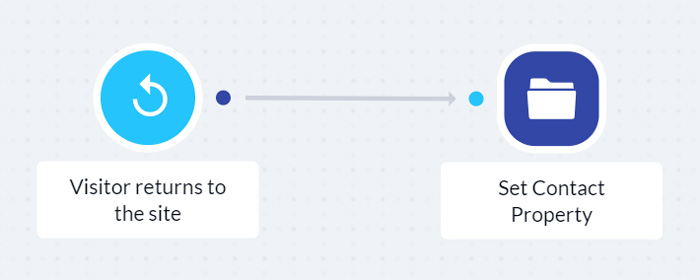
Now, whenever returning visitors come back to your website, the bot will activate and assign them the appropriate contact property.
While your bot is already in action, you can take it one step further and add just one more node to the same conversational flow. By doing so, your chatbot can send a welcome message to each visitor who decided to return to your website.

This is a great way to not only tag the returning visitor with a contact property needed for segmentation, but also send them a Welcome back message at the same time.
This very small change made to the chatbot can significantly improve the customer experience and engagement. In turn, this can influence whether your visitors stay on your website longer (and order what they came for) or leave again.

6. Create a customer segment based on cart abandonment
We know that returning visitors have higher conversion rates (complete the checkout process more often) compared to new visitors.
Nonetheless, there is no guarantee that each visitor, be it returning or the new one, will actually place an order—even if they added a product to their cart.
And this is where the issue of cart abandonment comes up.
Do you know what’s the cart abandonment rate for your store? If not, here’s a quick guide about how you can figure it out using segmentation.
To calculate the rate, you will first need a formula for cart abandonment rate (AR):

The table below shows you how we used the formula to calculate the abandonment rate for different segments based on their past purchase behavior.


Results?
As many as 70% of new shoppers abandon their shopping carts. What’s more, almost 80% of returning visitors with previous browsing history abandon shopping carts as well. Believe it or not, these values are close to the average global cart abandonment rate, which is around 70%.
As you can see, the stakes are high. That’s why you should focus on the segment with the visitors who abandon their carts.
You can start by adding two chatbots to your store that will apply custom properties (or tags) such as Item added to cart and Purchase made to the visitors on their respective shopping stages. Then, go to the Contacts list and filter your visitors by marking the values:
- Tag is: Added Item to Cart
- Tag is not: Completed Purchase

Alternatively, if you know a bit about web development (or know someone who does), you can add a short script to your website and enable cart abandonment tracking.
Ideas for segmenting customers based on cart abandonment:
| Cart Abandoners | Customers who did not complete the checkout process |
| Added Product | Customers who added a product to their cart |
| Purchased | Customers who placed an order |
| Product-Focused Shoppers | Customers who completed their shopping journey within some specific short period of time |
| Browsers | Customers who spend a relatively great deal of time at the store |
| Researchers | Customers who spend a great deal of time exploring a specific product page or product category |
A screenshot below shows how to create a chatbot for Browsers or Researchers (or any other time-based segment you come up with).

Specify the delay time in the Delay node to determine how long before the chatbot adds a contact property to your store visitor. In the example above, the bot will wait for 5 minutes until it moves to the next action node, Set Contact Property.
Read more: Learn how to improve your site’s cart abandonment rate using the help of essential shopping cart abandonment statistics. In addition, find out how to track an abandoned cart using Tidio.
7. Calculate CAC and conversion rate for segments based on demographics and location
To fully benefit from customer segmentation, you should combine market segmentation criteria with various customer data. These can be CAC (Customer Acquisition Cost), CLV (Customer Lifetime Value), Conversion Rate, Add-to-Cart Rate, and other ecommerce/marketing metrics.

For the sake of it, let’s assume that you run your business worldwide. So, for the geographical data, we chose the customers from the United States and Mexico.
Recently, you have noticed that the average conversion rate for your US customers is 8%, while for Mexico it’s less than 6%. You also observed that your store received traffic from 200 visitors from the US and 100 visitors from Mexico.
The first thing that may come to your mind is to focus on customers from the US (more visitors and higher conversions). But it can turn out that your CAC for customers from Mexico is 4 times lower! So, if you run Google Ads to acquire new customers, you may realize that the same keyword costs you much less in Mexico than in the US.
Now, here’s how you can segment your customers by country using Tidio.
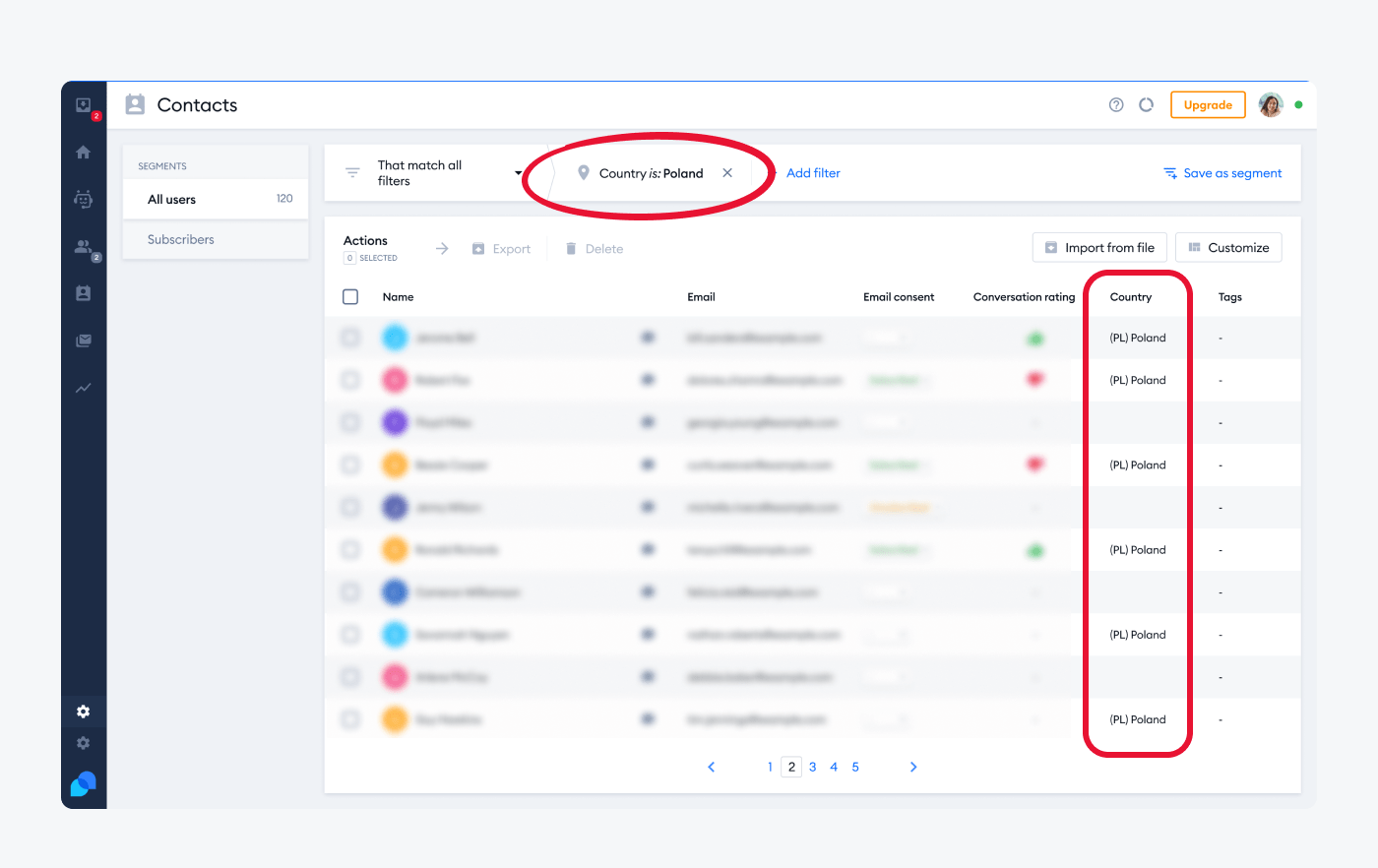
To do this, go to the Contacts list and filter the contacts according to the country. Then, create individual segments for each country you have on the list by clicking on Save as segment.
Similarly, you can segment customers according to many other types of criteria by using the +Add filter option. Some of the options include email, city, channel, phone, browser language, as well as the specific tag or contact property you created previously.

Remember that you can also combine other common characteristics, e.g. demographic ones.
Here are some ideas for segmenting customers based on their geographic location and demographics:
| Locals | Customers who are located in the same country as your store |
| Non-locals | Customers who are not located in the same country as your store |
| [City] locals | Customers who ordered to a certain city located in the same country as your store |
| [City] [country] | Customers who ordered from a specific foreign city and country |
| [Gender] [age] | Male/Female customers within a specific age range |
Customer segmentation: key takeaway
It’s easy to forget that your customers are not a uniform group of the same people. This is especially true if you deal with lots of visitors on a daily basis.
Sure, it’s far more convenient to think about them as a few ideal customers, or your core customer personas. But it can be a trap and sadly, most ecommerce businesses fall into it.
Don’t be that business. Make sure to regularly segment your customers, and it will become your secret weapon which can give you a much-needed competitive advantage.
So, let’s do a quick recap—
Here’s a list of things you can do to make the most of your customer segmentation strategy:
- Collect valuable data from the customers themselves
- Track and target your existing customers
- Create segments based on the customer satisfaction level
- Create segments based on product browsing history
- Treat returning visitors as a separate customer segment
- Create a customer segment based on cart abandonment
- Calculate CAC and conversion rate for different customer segments based on demographics and location
Also, the most common consumer segmentation examples include demographic, geographic, psychographic, behavioral, value- and needs-based models.
And remember—even if you create successful segments that work for you quite well, these can easily change over time. It’s especially true with the technologies (and society in general) undergoing continuous development.
Therefore, make sure you can easily update and optimize your segments with the new data, and then reuse them accordingly. By doing so, you’ll be able to stay on top of your customer segmentation game and drive continuous profits.

